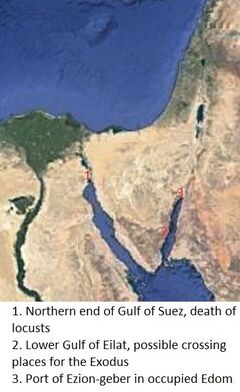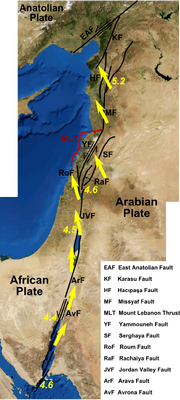
The Red Sea (Hebrew: 'ם־ ס֑וּף' Yam Suph) is the name of two bodies of water in the Old Testament, both of which are branches of the larger body by the same name that serves as a boundary between the continents of Asia (Saudi Arabia) and Africa (Egypt and Ethiopia).
Not known to the ancient patriarchs, the Red Sea in eastern Egypt became a boundary to be crossed when Yahweh forbid His chosen people to go along the shore of the Great Sea . Using a mighty wind from the west, God not only dried the sea floor, but held back walls of water long enough for the Israelites to get safely to the shore on the other side. That miracle ended when the solders followed in chariots, only to be drowned when the walls of water collapsed.
Though the western branch had been identified as the destination for the plague of locusts after they had done their damage to Egypt, the Israelites would have to pass through a wilderness before reaching the crossing point. Taking this into account, Moses is said to speak from a plain near "Suph"[1] at the end of the journey. Some older translations insert an italicized "Sea" but it is not in the Hebrew text. However, the place was close to the Gulf of Aqaba. It was of this body of water that the writer of the accounts of Solomon wrote concerning Solomon's ships with a more or less safe port in occupied Edom.
Etymology
Yam Suph was first called the "Red Sea" by the first known translators of the Old Testament--the "Seventy", a legendary team of translators in Egypt about 200 years before Christ. This is known by the Roman number LXX, or in Latin, the Septuagint. This translation of Ἐρυθρᾷ Θαλάσσῃ, or in English, "Red Sea" is followed by Luke in translating, or transcribing, Steven's sermon before the Sanhedrin[2] and by the writer to Hebrews in the "Faith chapter" concerning Moses[3]. In so accepting the centuries-old translation of Yam Suph, the New Testament writers confirm "the Red Sea" as a proper designation.
When the secretary wrote out Deuteronomy, he may have confirmed that Yam Suph was known as the "Sea of Edom". Since Edom means "red"[4] and the area nearby was called Suph, it may be that the translation goes even back to the beginning. Since the Egyptian loan word has no direct connection with the word "red", it must be assumed that a derived connotation lead to this designation. The loan word "suph" clearly means "reeds" like those into which the baby Moses was laid[5], so some connection to their color was likely the reason the word came to mean "reddish".
Creative commentators have seized the homonyms in the Hebrew language, סּ֑וּף and סוֹף as possible Hebrew names for the sea. These words mean "to end" and "an end" with a leaning toward to destroy. This is indeed an apt play on words (not unknown in Biblical writings), but the New Testament trumps the best scholarship and speculation.
Location
Though both the Gulf of Suez and the Gulf of Aqaba branch off the larger "Red Sea", only the latter meets most of the linguistic evidence. While it is true that the locusts were blown into waters east of the Nile and populated Egypt, the smaller gulf, which has its northern end south of the Dead Sea, fits the rest of the passages. The crossing would be somewhere near Midian where Moses had lived for forty years.
History

By Mikenorton - Own work, CC BY-SA 3.0, https://commons.wikimedia.org/w/index.php?curid=24723942
The world before the Great Flood is unknown due to the catastrophic restructuring accomplished by the break up of the single continent of the time[6]. Near the headwaters of the Euphrates River there is a rift that heads south, through what would become the lands first settled by the Canaanites, descendants of Ham. The flood was caused as the fountains of the "great deep" (underground reservoirs that provided the water for plants to live[7]) broke open with great force[8]. The rift that circled the earth came right down what became the Jordan valley, the Sea of Galilee, the Salt Sea, and the Red Sea.
This small gulf provided a way by sea to reach the far ends of the world. It provided an alternative way to get goods to and from the subcontinent of India and lands beyond. Ports like those used later by Solomon as a shipyard possibly were used by Semite seamen of the land of Uz , home of Job, in the time of Abraham. The descendants of Abraham's son Midian and of his grandson Esau (Edomites) were blessed with fertile lands along its shores.
In exile from Egypt, Moses fled to Midian, married a rancher's daughter, and raised a family in the shadow of Mount Horeb in the region of the Red Sea. And it was to that region that he led more than a million people.
